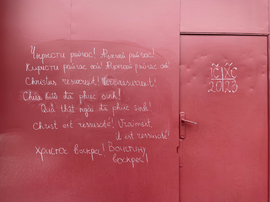
| Part of a series on the |
| Eastern Orthodox Church |
|---|
| Overview |

The Paschal greeting, also known as the Easter Acclamation or Easter Day Greeting, is an Easter custom among many Christian churches, including Eastern Orthodox, Oriental Orthodox, Roman Catholic, Anglican, Lutheran,[1] Methodist,[2] Presbyterian,[3] and Congregational.[4]
One offers the greeting "Christ is risen!" and the response is "Indeed He is Risen!" or "He is risen indeed!" with many variants in English and other languages (compare Matthew 27:64, Matthew 28:6–7, Mark 16:6, Luke 24:6, Luke 24:34).[5][6]
- ^ Carson, Emily (23 Apr 2022). "'He is risen' is a greeting for the ages". Rochester Post Bulletin. Post Bulletin and Forum Communications Company. Retrieved 9 April 2023.
- ^ "Easter Day Greeting". United Methodist Church Discipleship Ministries. United Methodist Church. Retrieved 9 April 2023.
- ^ Hardwick, Rev. Dr. Chip. "Worship Resource 2020" (PDF). psusa.org. Presbyterian Church (USA). Retrieved 9 April 2023.
- ^ "The Art and Practice of the Congregational Church". naccc.org. The National Association of Congregational Christian Churches. 3 March 2021. Retrieved 9 April 2023.
- ^ Kovacs, Judith L. (2005). 1 Corinthians: Interpreted by Early Christian Commentators. Wm. B. Eerdmans Publishing. p. 10. ISBN 9780802825773.
- ^ W.H. Withrow, M.A., D.D., F.R.S.C. (1904). Methodist Magazine and Review. 59: 550.
{{cite journal}}: Missing or empty|title=(help)CS1 maint: multiple names: authors list (link)